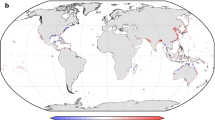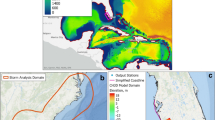Abstract
A technique to evaluate the risk of storm tides (the combination of a storm surge and tide) under present and enhanced greenhouse conditions has been applied to Cairns on the north-eastern Australian coast. The technique combines a statistical model for cyclone occurrence with a state-of-the-art storm surge inundation model and involves the random generation of a large number of storm tide simulations. The set of simulations constitutes a synthetic record of extreme sea-level events that can be analysed to produce storm tide return periods. The use of a dynamic storm surge model with overland flooding capability means that the spatial extent of flooding is also implicitly modelled. The technique has the advantage that it can readily be modified to include projected changes to cyclone behaviour due to the enhanced greenhouse effect. Sea-level heights in the current climate for return periods of 50, 100, 500 and 1000 years have been determined to be 2.0 m, 2.3 m, 3.0 m and 3.4 m respectively. In an enhanced greenhouse climate (around 2050), projected increases in cyclone intensity and mean sea-level see these heights increase to 2.4 m, 2.8 m, 3.8 m and 4.2 m respectively. The average area inundated by events with a return period greater than 100 years is found to more than double under enhanced greenhouse conditions.
Similar content being viewed by others
References
AUSLIG: 1994, GEODATA TOPO-250K Data User Guide, Version 1 Data, Ed 2. Australian Surveying &; Land Information Group, Commonwealth Department of Industry, Science and Resources, Canberra, Australia.
Basher, R.E. and Zheng, X.: 1995, Tropical cyclones in the southwest Pacific: spatial patterns and relationships to Southern Oscillation and sea surface temperature, J. Climate 8, 1249–1260.
Betts, H.: 1999, The implication of future climate change on floodplain planning at Gold Coast City. Proceedings, NSW Floodplain Managers' Conference, May 1999.
Blain, Bremner &; Williams Pty. Ltd.: 1985, Storm tide statistics - methodology. Prepared for the Beach Protection Authority, Dept. of Environment, Queensland. 25 pp.
Harper, B.: 1999, Storm tide threat in Queensland: history, prediction and relative risks, Queensland Department of Environment and Heritage, Conservation technical report No. 10. 24 pp.
Harper, B. A., Sobey, R. J., and Stark, K. P.: 1977, Numerical simulation of tropical cyclone storm surge along the Queensland coast, Part III - Cairns. Department of Civil and Systems Engineering, James Cook University, Townsville. 15 pp.
Holland, G. J.: 1980, An analytical model of the wind and pressure profiles in hurricanes, Mon. Wea. Rev. 108, 1212–1218.
Holland, G. J.: 1981, On the quality of the Australian tropical cyclone data base, Aust. Met. Mag. 29, 169–181.
Holland, G. J.: 1997, The maximum potential intensity of tropical cyclones, J. Atmos. Sci. 54, 2519–2541.
Holmes, J. D. and Moriarty, W.W.: 1999, Application of the Generalised Pareto Distribution to wind engineering, J. Wind Engineering and Industrial Aerodynamics 83, 1–10.
Hubbert, G. D., Holland, G. J., Leslie, L. M., and Manton, M. J.: 1991, A real-time system for forecasting tropical cyclone storm surges, Weather and Forecasting 6, 86–97.
Hubbert, G. D., Leslie, L. M., and Manton, M. J.: 1990, A storm surge model for the Australian region, Quart. J. Roy. Met. Soc. 116, 1005–1020.
Hubbert, G. D. and McInnes, K. L.: 1999a, A storm surge inundation model for coastal planning and impact studies, J. Coastal Research 15, 168–185.
Hubbert, G. D. and McInnes, K. L.: 1999b, Modelling storm surges and coastal ocean flooding, In: B. J. Noye (ed.), Modelling coastal sea processes, World Scientific Publishing Co., pp. 159–187.
IPCC: 1996, Climate change 1995: the science of climate change, Contribution of Working Group I to the second assessment report of the intergovernmental panel on climate change, Cambridge University Press, 572 pp.
IPCC: 2001, Climate change 2001 - the scientific basis, Cambridge University Press, 881 pp.
Lourenz, A.: 1981, Tropical cyclones in the Australian region: July 1909 to June 1980, Bureau of Meteorology report, October 1981.
Walsh, K., Allan, R., Jones, R., Pittock, A. B., Suppiah, R., and Whetton, P.: 1999, Climate change in Queensland under enhanced greenhouse conditions, CSIRO Atmospheric Research, PMB 1, Aspendale, VIC. 3195, Australia. 84 pp.
Walsh, K. J. E. and Ryan, B. F.: 2000, Tropical cyclone intensity increase near Australia as a result of climate change, J. Climate 13, 3029–3036.
Yeh, G.-T. and Chou, F.-K.: 1979, Moving boundary numerical surge model, J. Waterw. Port Coastal and Ocean Div. 105, 247–263.
Zerger, A.: 1996, Application of spatial analysis and GIS for modelling risk in storm surge prone areas of northern Queensland, Proc. National Disaster Reduction Conference, Surfers Paradise, Queensland, Sept. 1996, Inst. Eng. Australia, pp. 99–106.
Author information
Authors and Affiliations
Rights and permissions
About this article
Cite this article
Mcinnes, K.L., Walsh, K.J.E., Hubbert, G.D. et al. Impact of Sea-level Rise and Storm Surges on a Coastal Community. Natural Hazards 30, 187–207 (2003). https://doi.org/10.1023/A:1026118417752
Issue Date:
DOI: https://doi.org/10.1023/A:1026118417752




